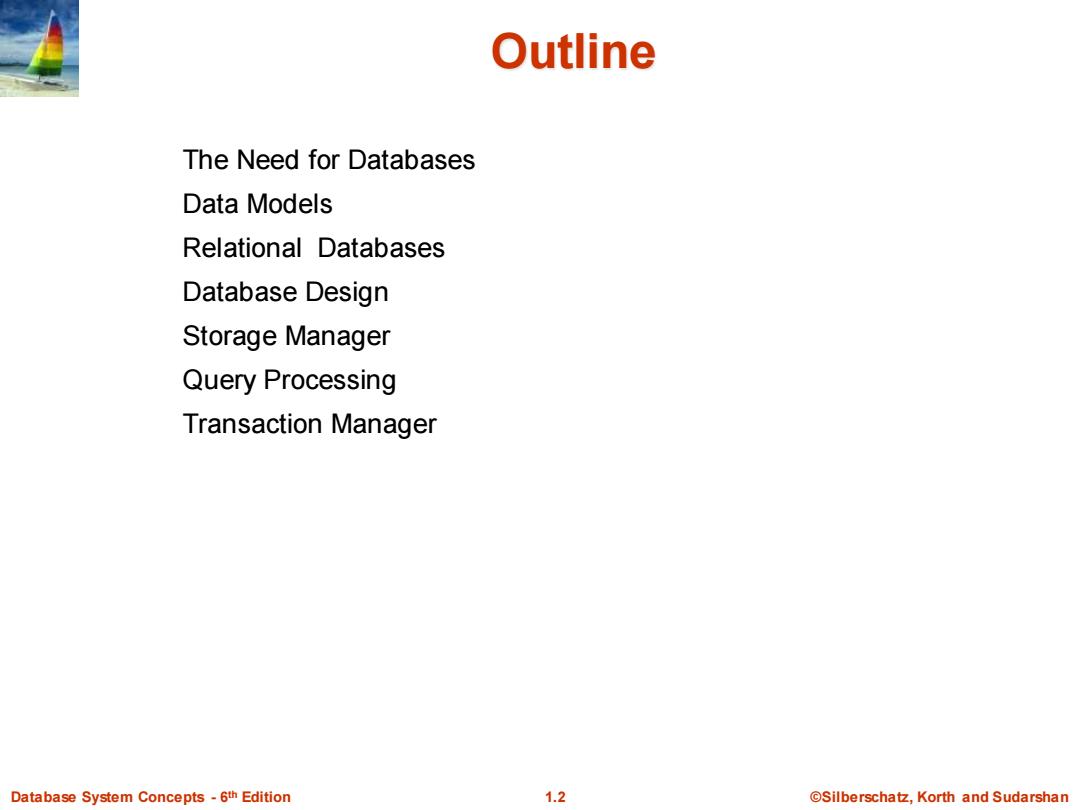
Outline The Need for Databases Data Models Relational Databases Database Design Storage Manager Query Processing Transaction Manager Database System Concepts-6th Edition 1.2 ©Silberschat乜,Korth and Sudarshan
Database System Concepts - 6 1.2 ©Silberschatz, Korth and Sudarshan th Edition Outline The Need for Databases Data Models Relational Databases Database Design Storage Manager Query Processing Transaction Manager
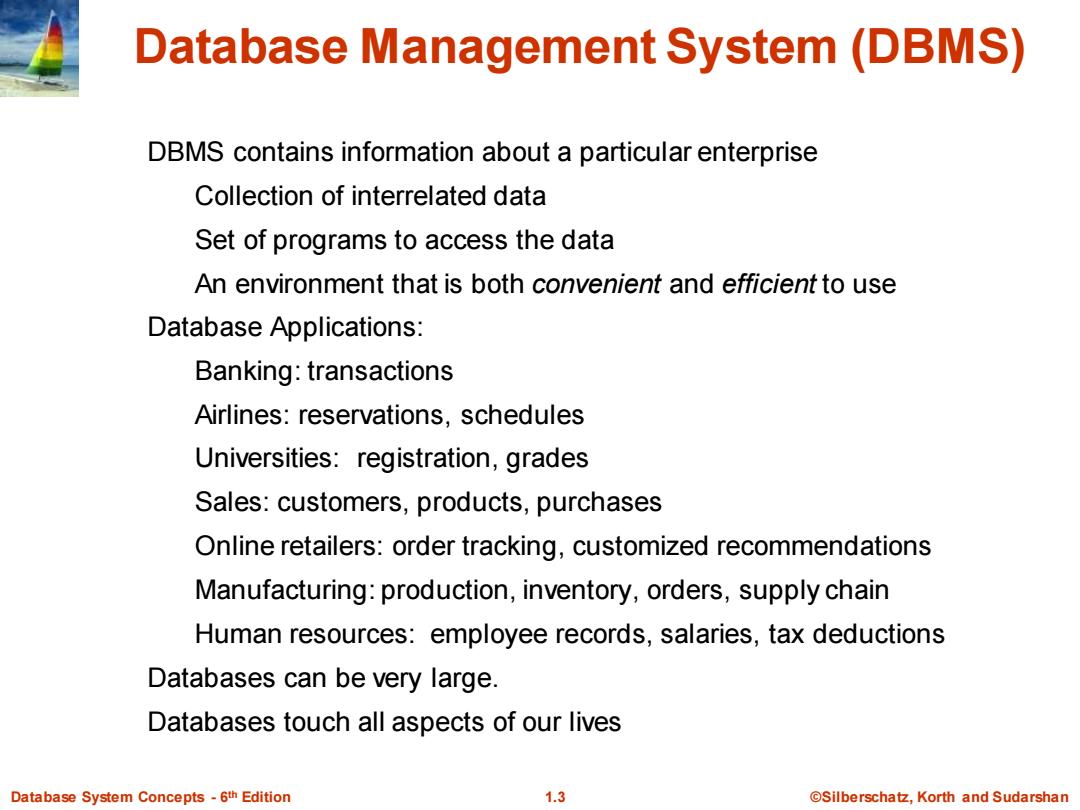
Database Management System (DBMS) DBMS contains information about a particular enterprise Collection of interrelated data Set of programs to access the data An environment that is both convenient and efficient to use Database Applications: Banking:transactions Airlines:reservations,schedules Universities:registration,grades Sales:customers,products,purchases Online retailers:order tracking,customized recommendations Manufacturing:production,inventory,orders,supply chain Human resources:employee records,salaries,tax deductions Databases can be very large. Databases touch all aspects of our lives Database System Concepts-6th Edition 1.3 ©Silberschat乜,Korth and Sudarshan
Database System Concepts - 6 1.3 ©Silberschatz, Korth and Sudarshan th Edition Database Management System (DBMS) DBMS contains information about a particular enterprise Collection of interrelated data Set of programs to access the data An environment that is both convenient and efficient to use Database Applications: Banking: transactions Airlines: reservations, schedules Universities: registration, grades Sales: customers, products, purchases Online retailers: order tracking, customized recommendations Manufacturing: production, inventory, orders, supply chain Human resources: employee records, salaries, tax deductions Databases can be very large. Databases touch all aspects of our lives
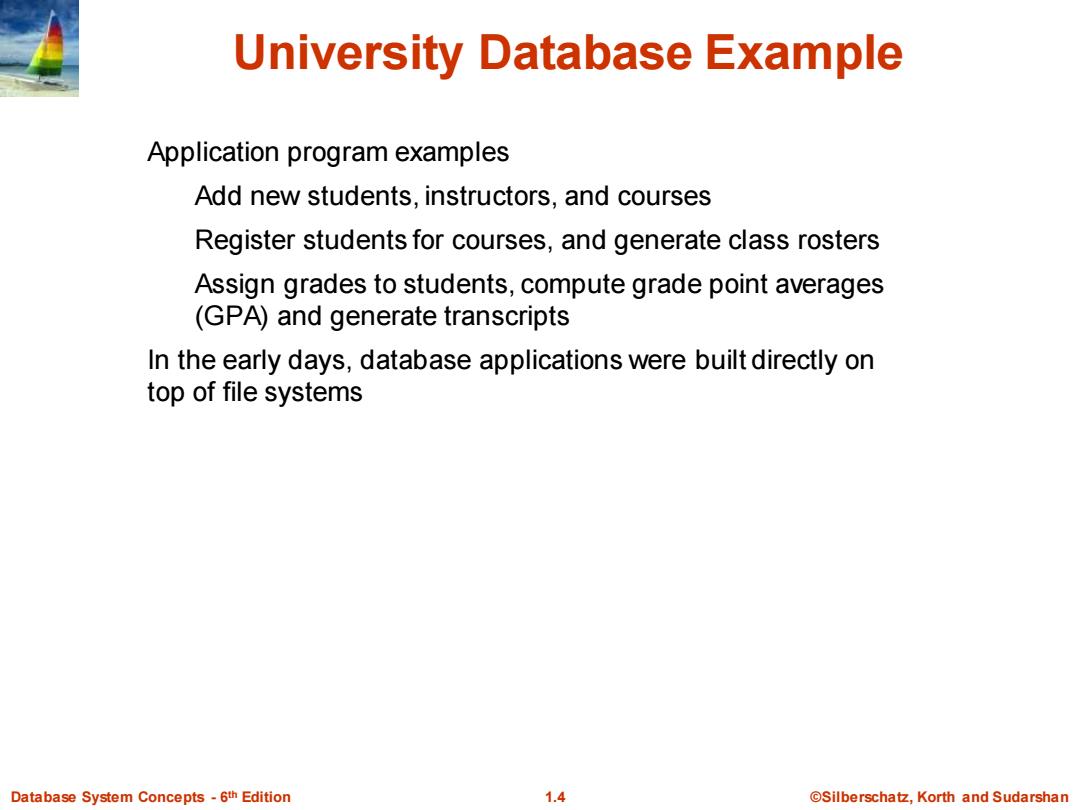
University Database Example Application program examples Add new students,instructors,and courses Register students for courses,and generate class rosters Assign grades to students,compute grade point averages (GPA)and generate transcripts In the early days,database applications were built directly on top of file systems Database System Concepts-6th Edition 1.4 @Silberschatz,Korth and Sudarshan
Database System Concepts - 6 1.4 ©Silberschatz, Korth and Sudarshan th Edition University Database Example Application program examples Add new students, instructors, and courses Register students for courses, and generate class rosters Assign grades to students, compute grade point averages (GPA) and generate transcripts In the early days, database applications were built directly on top of file systems
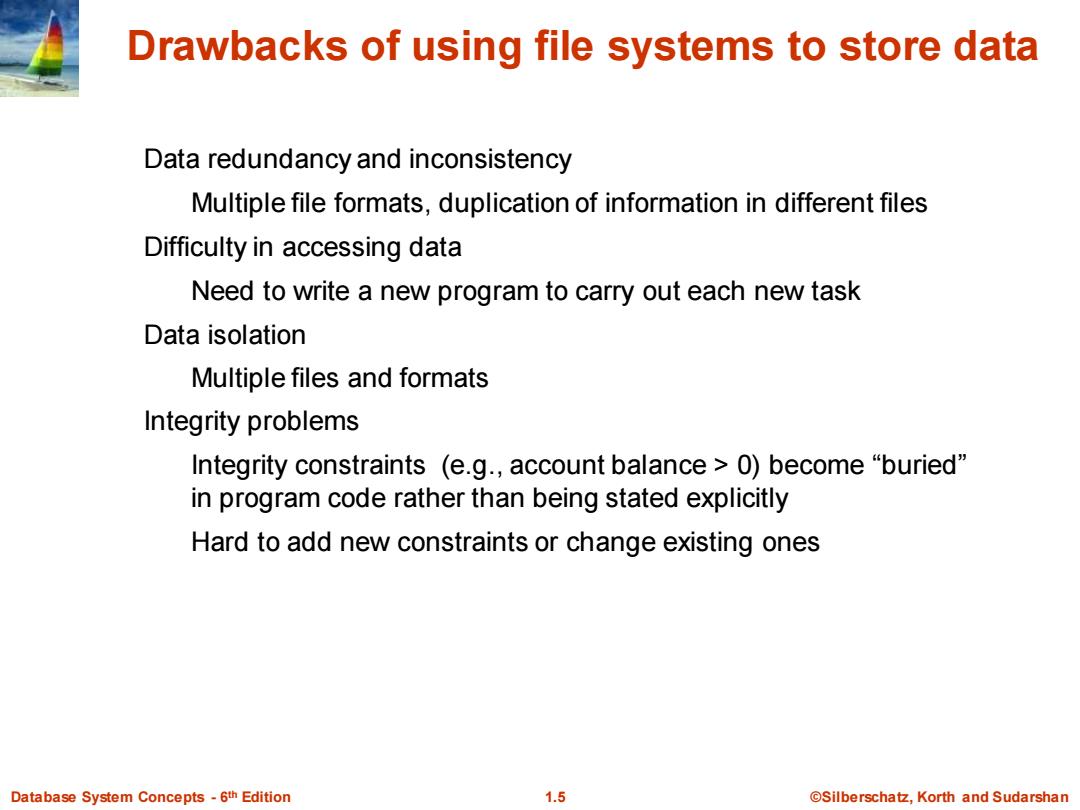
Drawbacks of using file systems to store data Data redundancy and inconsistency Multiple file formats,duplication of information in different files Difficulty in accessing data Need to write a new program to carry out each new task Data isolation Multiple files and formats Integrity problems Integrity constraints (e.g.,account balance 0)become "buried" in program code rather than being stated explicitly Hard to add new constraints or change existing ones Database System Concepts-6th Edition 1.5 @Silberschatz,Korth and Sudarshan
Database System Concepts - 6 1.5 ©Silberschatz, Korth and Sudarshan th Edition Drawbacks of using file systems to store data Data redundancy and inconsistency Multiple file formats, duplication of information in different files Difficulty in accessing data Need to write a new program to carry out each new task Data isolation Multiple files and formats Integrity problems Integrity constraints (e.g., account balance > 0) become “buried” in program code rather than being stated explicitly Hard to add new constraints or change existing ones

Drawbacks of using file systems to store data (Cont.) Atomicity of updates Failures may leave database in an inconsistent state with partial updates carried out Example:Transfer of funds from one account to another should either complete or not happen at all Concurrent access by multiple users Concurrent access needed for performance Uncontrolled concurrent accesses can lead to inconsistencies Example:Two people reading a balance (say 100)and updating it by withdrawing money(say 50 each)at the same time Security problems Hard to provide user access to some,but not all,data Database systems offer solutions to all the above problems Database System Concepts-6th Edition 1.6 ©Silberschat乜,Korth and Sudarshan
Database System Concepts - 6 1.6 ©Silberschatz, Korth and Sudarshan th Edition Drawbacks of using file systems to store data (Cont.) Atomicity of updates Failures may leave database in an inconsistent state with partial updates carried out Example: Transfer of funds from one account to another should either complete or not happen at all Concurrent access by multiple users Concurrent access needed for performance Uncontrolled concurrent accesses can lead to inconsistencies Example: Two people reading a balance (say 100) and updating it by withdrawing money (say 50 each) at the same time Security problems Hard to provide user access to some, but not all, data Database systems offer solutions to all the above problems
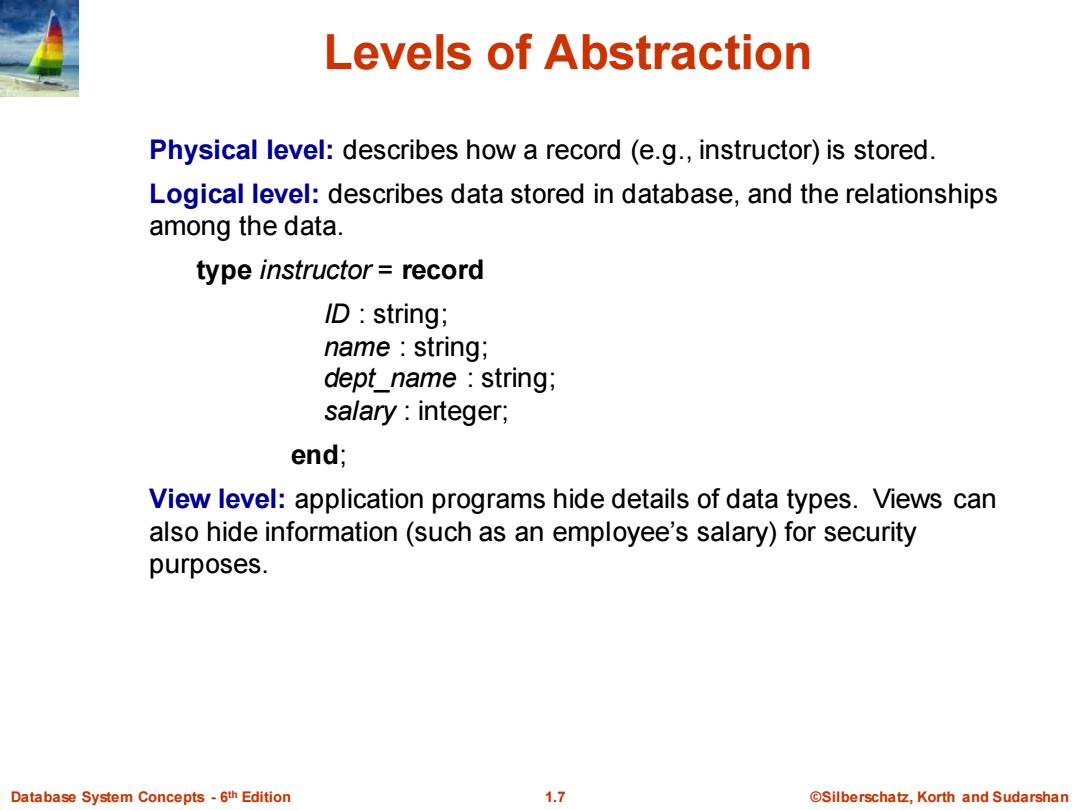
Levels of Abstraction Physical level:describes how a record (e.g.,instructor)is stored. Logical level:describes data stored in database,and the relationships among the data. type instructor record ID string; name string; dept name string; salary integer; end; View level:application programs hide details of data types.Views can also hide information(such as an employee's salary)for security purposes. Database System Concepts-6th Edition 1.7 @Silberschatz,Korth and Sudarshan
Database System Concepts - 6 1.7 ©Silberschatz, Korth and Sudarshan th Edition Levels of Abstraction Physical level: describes how a record (e.g., instructor) is stored. Logical level: describes data stored in database, and the relationships among the data. type instructor = record ID : string; name : string; dept_name : string; salary : integer; end; View level: application programs hide details of data types. Views can also hide information (such as an employee’s salary) for security purposes
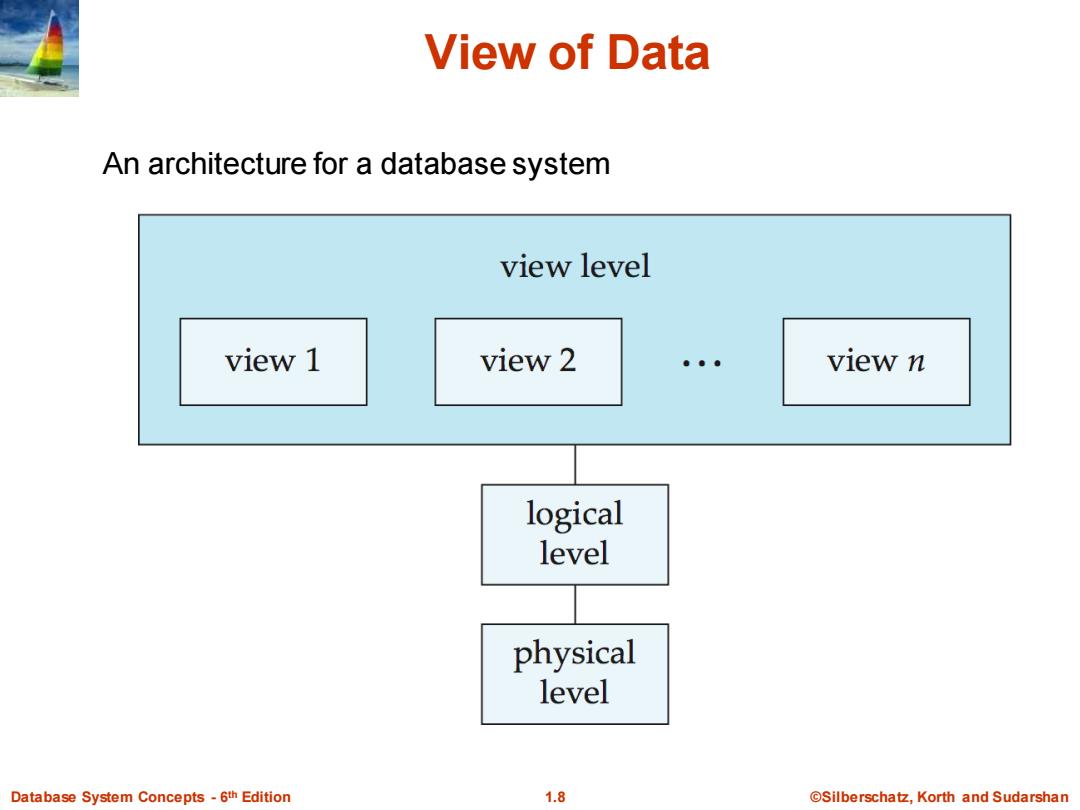
View of Data An architecture for a database system view level view 1 view 2 view n logical level physical level Database System Concepts-6th Edition 1.8 ©Silberschat乜,Korth and Sudarshan
Database System Concepts - 6 1.8 ©Silberschatz, Korth and Sudarshan th Edition View of Data An architecture for a database system
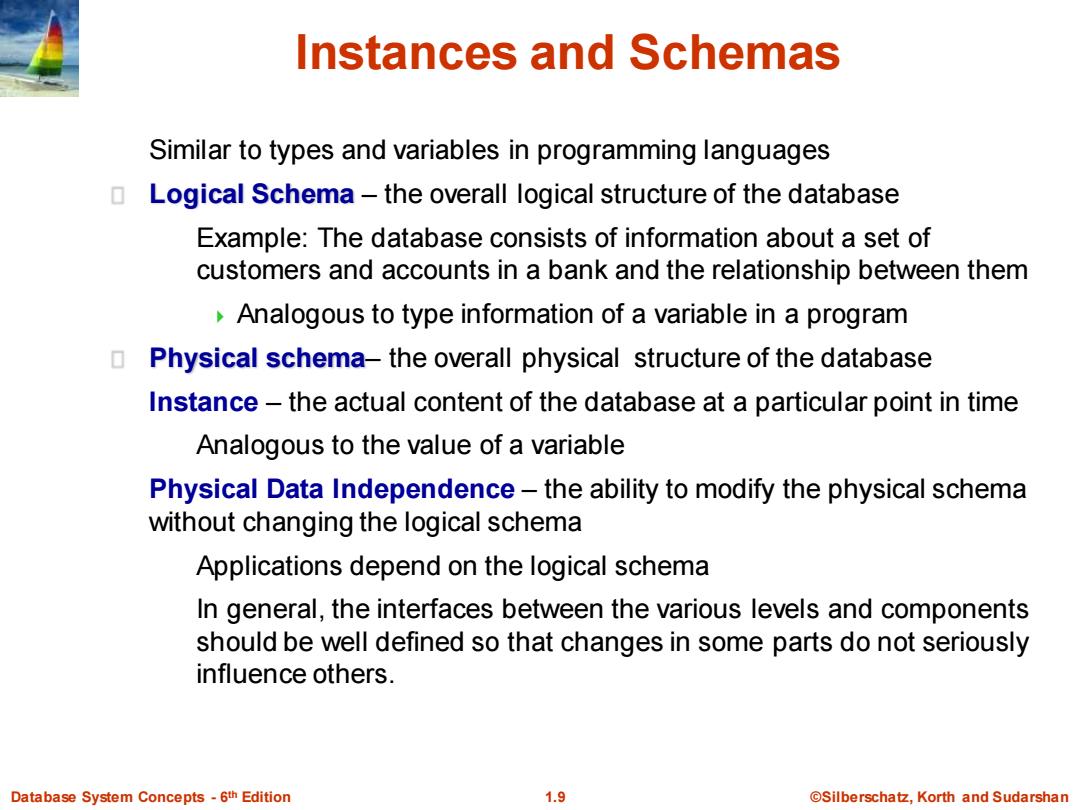
Instances and Schemas Similar to types and variables in programming languages Logical Schema-the overall logical structure of the database Example:The database consists of information about a set of customers and accounts in a bank and the relationship between them Analogous to type information of a variable in a program 0 Physical schema-the overall physical structure of the database Instance-the actual content of the database at a particular point in time Analogous to the value of a variable Physical Data Independence-the ability to modify the physical schema without changing the logical schema Applications depend on the logical schema In general,the interfaces between the various levels and components should be well defined so that changes in some parts do not seriously influence others. Database System Concepts-6th Edition 1.9 @Silberschatz,Korth and Sudarshan
Database System Concepts - 6 1.9 ©Silberschatz, Korth and Sudarshan th Edition Instances and Schemas Similar to types and variables in programming languages Logical Schema – the overall logical structure of the database Example: The database consists of information about a set of customers and accounts in a bank and the relationship between them Analogous to type information of a variable in a program Physical schema– the overall physical structure of the database Instance – the actual content of the database at a particular point in time Analogous to the value of a variable Physical Data Independence – the ability to modify the physical schema without changing the logical schema Applications depend on the logical schema In general, the interfaces between the various levels and components should be well defined so that changes in some parts do not seriously influence others
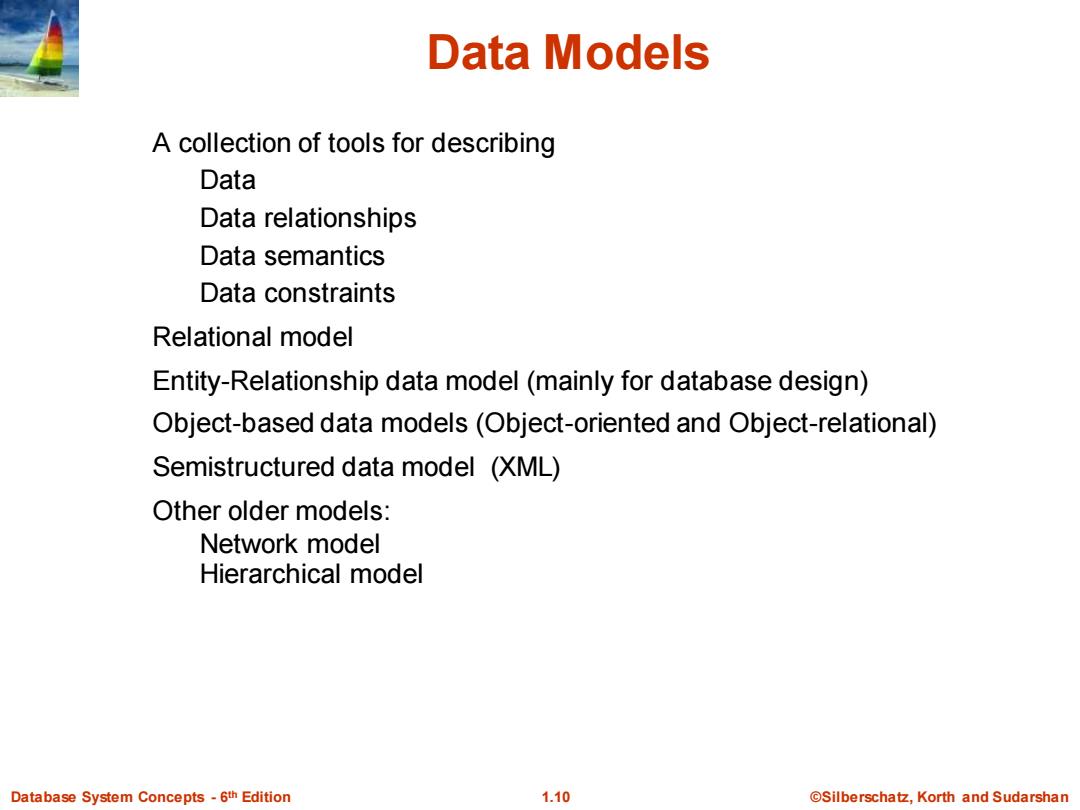
Data Models A collection of tools for describing Data Data relationships Data semantics Data constraints Relational model Entity-Relationship data model(mainly for database design) Object-based data models(Object-oriented and Object-relational) Semistructured data model (XML) Other older models: Network model Hierarchical model Database System Concepts-6th Edition 1.10 @Silberschatz,Korth and Sudarshan
Database System Concepts - 6 1.10 ©Silberschatz, Korth and Sudarshan th Edition Data Models A collection of tools for describing Data Data relationships Data semantics Data constraints Relational model Entity-Relationship data model (mainly for database design) Object-based data models (Object-oriented and Object-relational) Semistructured data model (XML) Other older models: Network model Hierarchical model
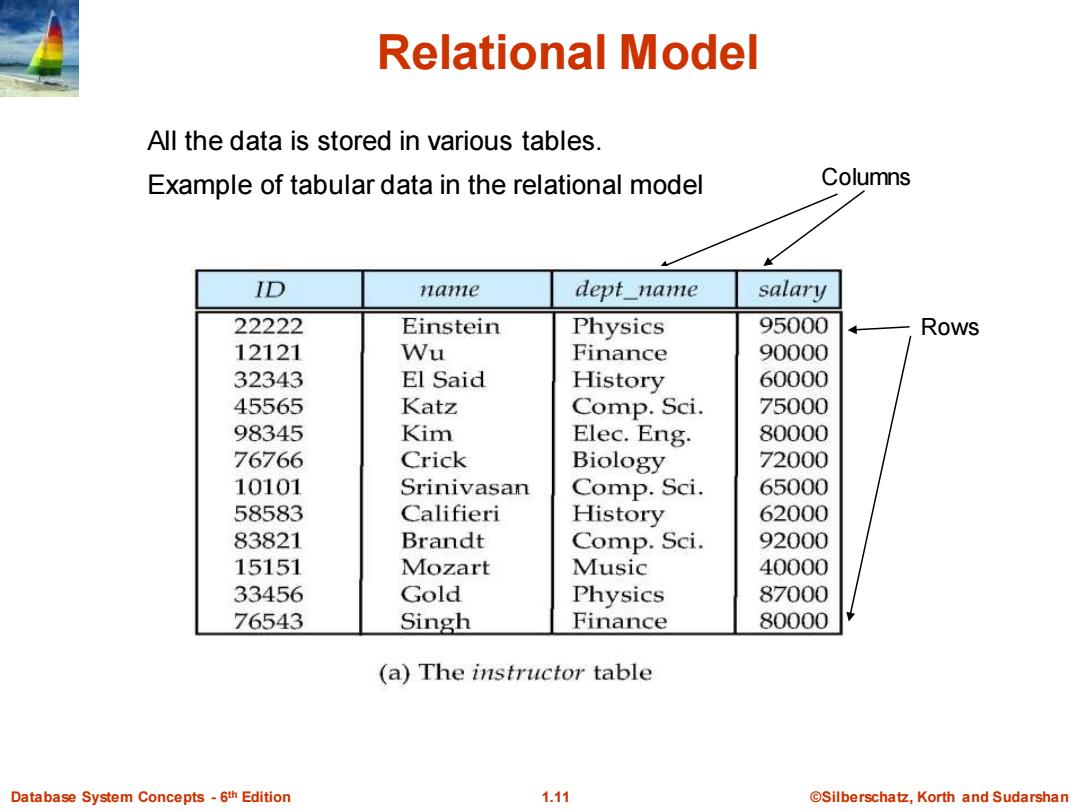
Relational Model All the data is stored in various tables. Example of tabular data in the relational model Columns ID name dept_name salary 22222 Einstein Physics 95000 Rows 12121 Wu Finance 90000 32343 El Said History 60000 45565 Katz Comp.Sci. 75000 98345 Kim Elec.Eng. 80000 76766 Crick Biology 72000 10101 Srinivasan Comp.Sci. 65000 58583 Califieri History 62000 83821 Brandt Comp.Sci. 92000 15151 Mozart Music 40000 33456 Gold Physics 87000 76543 Singh Finance 80000 (a)The instructor table Database System Concepts-6th Edition 1.11 ©Silberschat乜,Korth and Sudarshan
Database System Concepts - 6 1.11 ©Silberschatz, Korth and Sudarshan th Edition Relational Model All the data is stored in various tables. Example of tabular data in the relational model Columns Rows